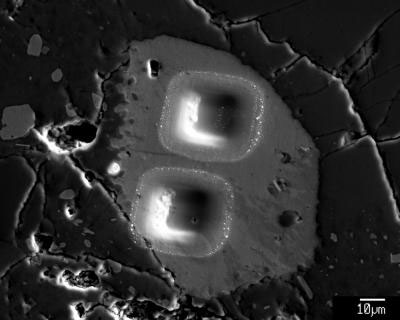| May 28, 2014 |
Water in moon rocks provides clues and questions about lunar history
|
|
(Nanowerk News) A recent review of hundreds of chemical analyses of Moon rocks indicates that the amount of water in the Moon's interior varies regionally – revealing clues about how water originated and was redistributed in the Moon. These discoveries provide a new tool to unravel the processes involved in the formation of the Moon, how the lunar crust cooled, and its impact history.
|
|
This is not liquid water, but water trapped in volcanic glasses or chemically bound in mineral grains inside lunar rocks. Rocks originating from some areas in the lunar interior contain much more water than rocks from other places. The hydrogen isotopic composition of lunar water also varies from region to region, much more dramatically than in Earth.
|
 |
| This shows secondary electron image of pits left by ion microprobe analyses of a heterogeneous apatite grain in Apollo sample 14321, 1047. Water has now been detected in apatite in many different lunar rock types. (Image: Katharine L. Robinson, University of Hawaii, HIGP)
|
|
The present consensus is that the Moon formed as the result of a giant impact of an approximately Mars-sized planetesimal with the proto-Earth. The water in the Moon is a tracer of the processes that operated in the hot, partly silicate gas, partly magma disk surrounding Earth after that impact.
|
|
The source of the Moon's water has important implications for determining the source of Earth's water, which is vital to life. There are two options: either, water was inherited by the Moon from the Earth during the Moon-forming impact, or it was added to the Moon later by comets or asteroids. It might also be a combination of these two processes.
|
|
"Basically, whatever happened to the Moon also happened to the Earth," said Katharine Robinson, lead author of the study and Graduate Assistant at the University of Hawaii - Manoa (UHM) School of Ocean and Earth Science and Technology.
|
|
Robinson and Researcher G. Jeffrey Taylor, both at the UHM Hawaii Institute of Geophysics and Planetology, compiled water measurements from lunar samples performed by colleagues from around the world, as well as their own. Specifically, they measured hydrogen and its isotope, deuterium (hydrogen with an extra neutron in its nucleus) with ion microprobes, which use a focused beam of ions to sputter ions from a small rock sample into a mass spectrometer. The ratio of hydrogen to deuterium can indicate the source of the water or trace magmatic processes in the lunar interior.
|
|
When water was first discovered in lunar samples in 2008, it was very surprising because from the time Apollo astronauts brought lunar samples, scientists thought that the Moon contained virtually no water.
|
|
"This was consistent with the idea that blossomed during the Origin of the Moon conference in Kona in 1984 -- that the Moon formed by a giant impact with the still-growing Earth, leading to extensive loss of volatile chemicals. Our work is surprising because it shows that lunar formation and accretion were more complex than previously thought," said Robinson.
|
|
The study of water in the Moon is still quite new, and many rocks have not yet been studied for water. The HIGP researchers have a new set of Apollo samples from NASA that they will be studying in the next few months, looking for additional clues about the early life of Earth and the Moon.
|

